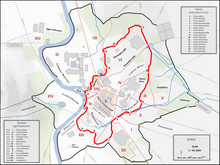Целимонтанские ворота
Материал из Википедии — свободной энциклопедии


Целимонтанские ворота (лат. Porta Caelimontana, или Celimontana) — ворота Сервиевой стены на холме Целий (Caelius Mons) в Риме[1]. Сквозь ворота проходила дорога Via Caelimontana. Предполагается, что ворота сохранились до наших дней в качестве арки Долабеллы[2], или же что на их месте была построена средневековая арка Arcus Basilidis[3]. По всей вероятности, ворота располагались южнее от Эсквилинских ворот[4].
Во времена принципата Октавиана Августа, ворота были перестроены[5]. Согласно надписям, в районе 10 года нашей эры, во времена консульства Долабеллы и Силана, на предполагаемом месте расположения ворот была построена Арка Долабеллы, однако учёные до сих пор не сходятся во мнении, является ли арка реконструкцией ворот[2]. Арка была объединена с поддерживающей структурой акведука Аква Клавдия, построенного во времена Нерона, что, предположительно, произошло во время перестройки Рима после Великого пожара 64 года[6].
Во времена Ренессанса проезд сквозь Целимонтанские ворота стал платным[7]. В конце XIX — начале XX столетий с южной стороны ворот были обнаружены римские гробницы[8].
Примечания
[править | править код]- ↑ Lawrence Richardson, A New Topographical Dictionary of Ancient Rome (Johns Hopkins University Press, 1992), pp. 304—305; Hodder Michael Westropp, Early and Imperial Rome (London, 1884), p. 59.
- ↑ 1 2 Thomas H. Dyer, "Roma, " in Dictionary of Greek and Roman Geography, edited by William Smith (London, 1873), vol. 2
- ↑ Platner, Samuel Ball; Ashby, Thomas. Porta_Caelimontana (англ.). A Topographical Dictionary of Ancient Rome. Bill Thayer’s Web Site.
- ↑ Cic. in Pis. 55, 61; cf. Liv. II.11; App. BC I.58
- ↑ Eireann Marshall, Death and Disease in the Ancient City (Routledge, 2000), p. 87.
- ↑ Peter J. Aicher, Guide to the Aqueducts of Ancient Rome (Bolchazy-Carducci, 1995), pp. 61ff, especially p. 67.
- ↑ Gotthold Ephraim Lessing, Lessing’s Laokoon (Oxford: Clarendon Press, 1878), p. xii.
- ↑ Jocelyn M.C. Toynbee, Death and Burial in the Roman World (Johns Hopkins University Press, 1971), p. 117.
Text is available under the CC BY-SA 4.0 license; additional terms may apply.
Images, videos and audio are available under their respective licenses.
